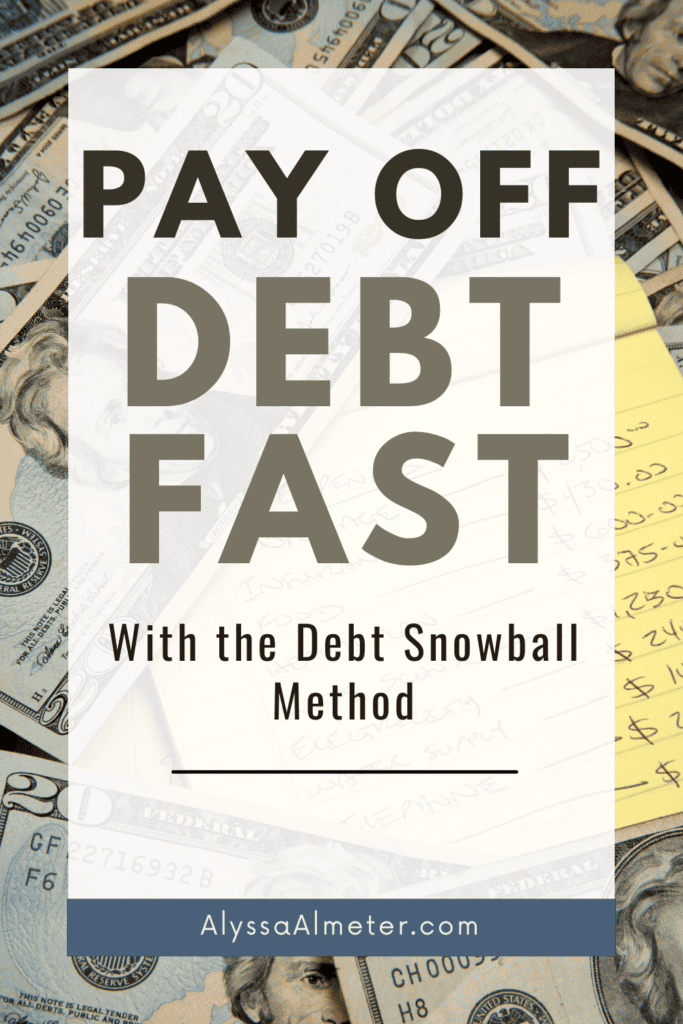This post may contain affiliate links. As an Amazon Associate I may earn from qualifying purchases at no additional costs to you. Please see the Policies pages for more info.
Paying Off Debt With The Debt Snowball Method
Between car payments, student loans and credit cards, do you feel like you will never be out of debt? Interest keeps piling up but the balance doesn’t get any smaller? With the right plan in place, you can pay off those debts! The Debt Snowball and Debt Avalanche are 2 debt payoff methods that you can use to pay off debt faster. I will explain the difference between the 2 methods and why I am a fan of the debt snowball.
What is the Debt Snowball Method?
In the debt snowball method you will list all your debts in order from the smallest balance to the largest, regardless of interest rate. The goal here is to pay off the smallest loan first by making extra payments on the minimum balance while paying the minimum balances of the rest of your debts.
Because I’m a visual person and I like numbers, here is an example of a debt snowball, totalling $33,500 with a total minimum monthly payment of $752.
| Loan | Balance | Minimum Payment | Interest Rate |
| Student Loan 1 | $2,000 | $50 | 3.00% |
| Student Loan 2 | $7,000 | $154 | 6.55% |
| Student Loan 3 | $9,500 | $211 | 6.55% |
| Car | $15,000 | $337 | 2.69% |
| Total | $33,500 | $752 |
Start by making extra payments on Student Loan 1. Let’s say you can pay $1,000 a month towards your debt. Your current monthly payment for all minimum payments is $752 so that gives you $248 extra ($1,000 – $752) you can put towards Student Loan 1 each month, making your new monthly payment on Student Loan 1 $298.
Continue with that payment each month until it is paid off. Then roll over that amount to the next loan’s minimum amount. In the example above, the minimum monthly payment on Student Loan 2 will become $402 ($154 + 248).
As you can see, as you go the payments for each loan keep getting bigger and bigger (like packing a snowball).
This is how you pay off debt early!
What is the Debt Avalanche Method?
In the debt avalanche method you will list all your debts in order from largest interest rate to smallest interest rates. The goal is to pay off the loan that has the highest interest rate first by applying extra payments each month. As you are doing this you will continue to pay the minimum balances on your other loans.
With the same example as above, this is how you would list the loans (largest to smallest interest rate).
| Loan | Balance | Minimum Payment | Interest Rate |
| Student Loan 2 | $7,000 | $154 | 6.55% |
| Student Loan 3 | $9,500 | $211 | 6.55% |
| Student Loan 1 | $2,000 | $50 | 3.00% |
| Car | $15,000 | $337 | 2.69% |
| Total | $33,500 | $752 |

The payment method is the same as the debt snowball, adding more to the first minimum payment and rolling it over into the next one as you go. The difference here is which one you start with.
Which Debt Payoff Method is Better?
You are probably thinking that you should pay off your highest interest rates loans first in order to save money on that interest. And while, yes you do want to save as much money as you can from interest, it isn’t that simple.
I suggest using the debt snowball method that focuses on paying off your smallest loan balance first because it gives you momentum.
If you have several loans it may feel overwhelming to start with the highest interest rate loan first because that loan may also have a higher balance, therefore it can take much longer to pay it off. That could be discouraging during your debt free journey.
How the Debt Snowball Worked for Me
When I started making payments on my student loans I wasn’t familiar with the debt snowball or the debt avalanche. I was told to pay off the loans with the highest interest rate first (the debt avalanche method, even though I didn’t know it had a name at the time.)
So that’s what I did.
But at the same time it didn’t entirely make sense to me. If I had loans that were much smaller, even though they didn’t have the highest interest rate, sometimes I would focus on paying those off just to clear them out.
I was all over the place.
I didn’t gain much traction in the first 4 years of paying on my student loans – until I heard about the debt snowball method!
That’s when everything changed and I finally was organized and had a plan that worked! I put as much money as I could on my debt snowball and finally paid my loans off within about a year and a half!

Debt Snowball vs. Debt Avalanche
Sill not convinced that you should focus on the smallest loan balance first? The let’s go back to the example listed above.
Undebt.it has an excellent online calculator you can use to calculate when your debt payoff date and compare the debt snowball vs. debt avalanche method. I entered the example above to compare numbers.
For both methods the calculator provides Total Principal and Interest Paid, Total Interest Paid, Percent Paid in Interest and Years and Months to Debt Freedom.
Here is a chart that compares both methods against only paying the minimum payments on everything.
| Pay Only Minimums | Debt Snowball | Debt Avalanche | |
| Total Principal and Interest | $36,390 | $35,846 | $35,741 |
| Total Interest | $3,425 | $2,349 | $2,244 |
| % Paid in Interest | 9.41% | 6.55% | 6.28% |
| Years to Debt Free | 4.1 Years (49 months) | 2.8 Years (34 months) | 2.8 Years (34 months) |
As you can see, by making an extra $248 payment each month, the debt will be gone 15 months earlier with the debt snowball or debt avalanche!
The difference in money saved versus the debt snowball and debt avalanche is not that much in the grand scheme of things. It’s only $105 more with the debt snowball but the first debt ($2,000) will be paid off in 7 months. The first debt ($7,000) will take 19 months for the debt avalanche.
That is 7 months vs. 19 months for your first win.
The debt snowball is about achieving quick wins along the way. That is what will give you momentum to keep going!
It’s a mental game, just as much as it is a math game.
When Should I Start the Debt Snowball?
There is one thing you should have in place before you start paying off your debt and that is a starter emergency fund of $1,000. This is Baby Step 1 in Dave Ramsey’s 7 Baby Steps to Financial Peace. A small emergency fund will give you a little cushion when unexpected expenses come up so that you don’t have to use a credit card while paying off debt (and going further into debt).
Once you have a starter emergency fund in place, then it’s time to tackle your small debts (everything but a mortgage) with the debt snowball (Baby Step 2)!
Conclusion
If you really want to pay off debt fast, you can’t be scattered in your approach. The debt snowball method is an intentional plan that will give you momentum and help you pay off debt faster.
Becoming debt free is one key element to overall financial wellness. Start implementing your debt snowball plan soon and track your progress on my free Financial Wellness Checklist.
Related Articles to Help You Pay Off Debt
5 Ways to Stay Motivated While Paying Off Debt
The Best Way to Pay Off Multiple Credit Cards
Mastering Financial Wellness: Tips and Tools
How to Set Short Term Financial Goals


